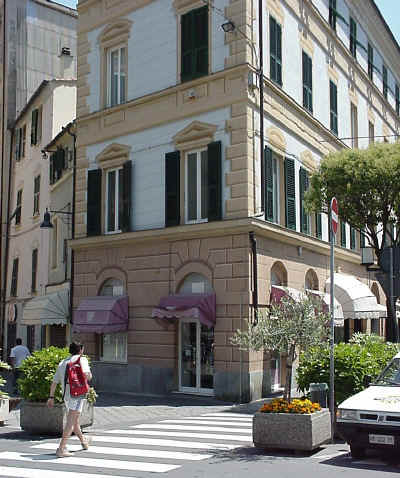 |
 |
 |
|
We crossed the border from France to Italy and stopped first in the resort town of San Remo. From our perspective on the sea, the coast of Italy immediately looked different, even though we'd only crossed the coast of France minutes before. Miles of rectangular greenhouses dotted the hills and, in some cases, covered them. This should not have surprised us; the westernmost coast of Italy is often called the La Riviera dei Fiori, the Riviera of the Flowers. Along the border towns, the locals speak French as well as Italian, and like most resort areas, people in the hospitality industry often speak English as well. |
|
|
|
|
|
The architectural technique of trompe l'oeil (which means "fool the eye") is everywhere along the coast, even in the smallest towns. The building shown at right is in Savona. Only the three horizontal ledges just under the three rows of windows are real. The arches above the windows, the appearance of beige bricks, and the appearance of shadows are all painted onto the facade. This technique has also been common in some of the churches we've visited. We'll spend five minutes looking at a ceiling and say, "It's real", then come back later and see that the architectural details are trompe l'oeil. |
 |
|
Frescoes and trompe l'oeil show up in the grandest of churches and palazzi, and often on ordinary houses as well. Historically, stone and marble masonry was not particularly expensive, so cost might not be the main reason for the amusing artwork. One alternative explanation offered is that people living on the narrow streets in the old towns wanted to offer architectural detail on the buildings without interfering with the scarce public space. It's common to see arches across the small streets, and occasionally the upper floors of the adjacent buildings will connect with rooms built on top of the arches. The arches undoubtedly provide some stability for the medieval houses, and they make the streets appear cozy and inviting. |
|
|
Combine the tiny passageways with the great weather and the high cost of fuel, and you'll conclude that motorbikes are a great way to get around in Liguria. This isn't the parking lot of a huge train station. It's just a square in the medium-sized town of San Remo on a normal day. |
 |
|
In the land of Bernini and Michelangelo, we are never too surprised to find extraordinary works of art in the most isolated places. We took a bus inland to the town of Taggia, a village of fewer than 14,000 people today. The convent of San Domenico was completed in 1490 and immediately drew the interest of local artists. |
|